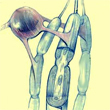Monday, 3 February 2014
Glial Cells Too Are Sensitive to the Environment
 For a long time, the brain’s glial cells were assumed to be mere “filler” between the neurons. For a while after that, the glial cells were assumed to serve primarily nutritive functions. But now, year after year, research findings are showing glial cells to be more and more complex. For example, recent studies have shown their role in brain plasticity and how social isolation can disrupt it.
For a long time, the brain’s glial cells were assumed to be mere “filler” between the neurons. For a while after that, the glial cells were assumed to serve primarily nutritive functions. But now, year after year, research findings are showing glial cells to be more and more complex. For example, recent studies have shown their role in brain plasticity and how social isolation can disrupt it.
More and more studies indicate that people who experience severe neglect and social isolation as children display cognitive and social impairments as adults. To examine this phenomenon, two research teams recreated these unfavourable conditions for baby mice by placing them in isolation for several weeks.
What the researchers observed was amazing. Oligodendrocytes are the glial cells that produce the myelin sheath—a fatty layer that surrounds neurons’ axons and serves as an electrical insulator, thus accelerating the conduction of nerve impulses. The myelin sheath is essential for neurons to function properly. But in the mice that the researchers subjected to social deprivation as babies, the oligodendrocytes failed to mature, and so the myelin was much thinner.
This finding means that neurons are not the only brain cells that can be modified by the environment: oligodendrocytes too display such plasticity. The researchers even identified a metabolic pathway by which social isolation leads to reduced myelination. This pathway involves the production of neuregulin-1 (NRG1, a protein essential for healthy brain development) and its receptor, ErbB3.
This reduced myelin production was observed in the prefrontal cortex, a part of the brain that is heavily involved in control of the emotions and in high-level cognitive functions. One of these studies noted that such changes in the myelination of the cortex are observed in certain psychiatric disorders, such as depression. And another study showed that the myelin sheath develops more slowly in the cortexes of humans than in those of chimpanzees and takes far longer to mature; the maturation period extends beyond adolescence into early adulthood. But this longer maturation period for the myelin associated with the emergence of specifically human cognitive functions entails greater vulnerability as well.
The plasticity of the glial cells is beginning to help us understand the mechanisms underlying this vulnerability. Thus, although glial cells may be less numerous than was once believed, they are certainly more important too.
![]() How Early Social Deprivation Impairs Long-Term Cognitive Function
How Early Social Deprivation Impairs Long-Term Cognitive Function
![]() A Critical Period for Social Experience–Dependent Oligodendrocyte Maturation and Myelination
A Critical Period for Social Experience–Dependent Oligodendrocyte Maturation and Myelination
![]() New Form of Brain Plasticity: How Social Isolation Disrupts Myelin Production
New Form of Brain Plasticity: How Social Isolation Disrupts Myelin Production
![]() Impaired adult myelination in the prefrontal cortex of socially isolated mice
Impaired adult myelination in the prefrontal cortex of socially isolated mice
![]() Human Brains Develop Wiring Slowly, Differing from Chimpanzees
Human Brains Develop Wiring Slowly, Differing from Chimpanzees
![]() Prolonged myelination in human neocortical evolution
Prolonged myelination in human neocortical evolution
From the Simple to the Complex | Comments Closed







